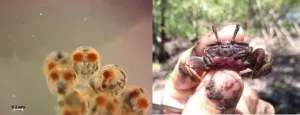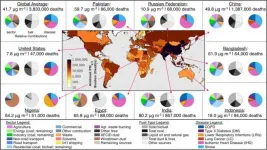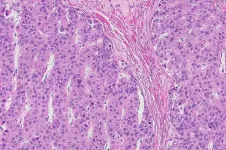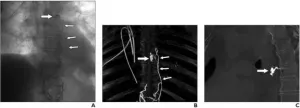(Press-News.org) Albeit very small, with a carapace width of only 3 cm, the Atlantic mangrove fiddler crab Leptuca thayeri can be a great help to scientists seeking to understand more about the effects of global climate change. In a study published in the journal Estuarine, Coastal and Shelf Science, Brazilian researchers supported by São Paulo Research Foundation - FAPESP show how the ocean warming and acidification forecast by the end of the century could affect the lifecycle of these crustaceans.
Embryos of L. thayeri were exposed to a temperature rise of 4 °C and a pH reduction of 0.7 against the average for their habitat, growing faster as a result. However, a larger number of individuals died before reaching the final embryonic stage compared with those allowed to remain in conditions typical for the environment normally inhabited by the species.
"This crab is very important ecologically. Its burrows contribute to the organic matter cycle, and its larvae serve as food for many other species. We can therefore assume that the alterations to its embryos caused by climate change will have a cascade effect. Animals like these with a longer embryonic stage are particularly endangered," said Tânia Márcia Costa, principal investigator for the project. Costa is a professor at the Bioscience Institute of São Paulo State University's Coast Campus (IB-CLP-UNESP) in São Vicente.
The project was supported by the FAPESP Research Program on Global Climate Change (RPGCC).
The temperature rise simulated in the experiments was based on the forecast for the end of the century made by the Intergovernmental Panel on Climate Change (IPCC). The parameter for the change in pH came from a study published in Nature in 2003 by researchers from United States.
L. thayeri is tiny and extremely abundant, with a typical mangrove serving as home for some 100 individuals per square meter. The species is often called an "ecosystem engineer" because to build chimney burrows in which to shelter, reproduce and incubate eggs, it moves organic matter from deep mud to the surface, where smaller organisms feed on the nutrients, as shown by the São Vicente group in an article
published in 2017.
"More research is needed to understand the combined effects of climate stressors on organisms, especially in the initial stages of their lives. These are usually the most sensitive to warming, falling pH levels and other stresses associated with climate change. The few studies that have been done used very generic values for temperature and acidity, whereas mangroves are highly dynamic and have their own microclimate," said Juan Carlos Farias Pardo, currently a PhD candidate at Norway's University of Agder (UiA) and the Norwegian Institute for Water Research (NIVA).The study was conducted as part of his master's research at IB-CLP-UNESP with a scholarship from FAPESP.
In the laboratory
To reproduce the crab's habitat as accurately as possible, the researchers spent months going into the field to measure temperature, salinity and acidity in the burrows where ovigerous (egg-laying) females live. The data was used for control in the laboratory experiments.
Eggs were removed from females and placed in water with the same salinity as in the habitat. Embryos were exposed to different combinations of temperature (26 °C or 30 °C) and pH (6.9 or 6.2). Observations were conducted for ten days. Embryos of this species are expected to develop completely in this timeframe, with fully formed eyes and strong heartbeats.
In the experiments, embryos developed faster in warmer, more acid water than the control group but also died more than embryos kept in conditions equivalent to those of the habitat. Egg volume was smaller in warmer water (30 °C) with normal acidity, and larger in similarly warm but more acid water.
"We concluded that faster development isn't necessarily better. They grew faster in response to the stressors but died more frequently. Larger egg volume in more acid water may have been a consequence of less efficient gas exchange, making them swell up," Pardo said, adding that the group is preparing more experiments to investigate later stages of development in the same species.
"Even if 100% of the embryos survive these climate changes, this is only the first stage of development. Mortality is naturally high before they reach adulthood because of their many predators. In any case, we don't know how this level of stress on the embryo will affect later stages," Costa said.
Previous research by the group showed how rising temperatures force physiological adaptations in two other species of fiddler crab, and influence territorial expansion in a third.
In a new project supported by FAPESP, Costa will investigate how stresses deriving from climate change affect interactions between herbivores and plants, predators and prey.
INFORMATION:
About São Paulo Research Foundation (FAPESP)
The São Paulo Research Foundation (FAPESP) is a public institution with the mission of supporting scientific research in all fields of knowledge by awarding scholarships, fellowships and grants to investigators linked with higher education and research institutions in the State of São Paulo, Brazil. FAPESP is aware that the very best research can only be done by working with the best researchers internationally. Therefore, it has established partnerships with funding agencies, higher education, private companies, and research organizations in other countries known for the quality of their research and has been encouraging scientists funded by its grants to further develop their international collaboration. You can learn more about FAPESP at http://www.fapesp.br/en and visit FAPESP news agency at http://www.agencia.fapesp.br/en to keep updated with the latest scientific breakthroughs FAPESP helps achieve through its many programs, awards and research centers. You may also subscribe to FAPESP news agency at http://agencia.fapesp.br/subscribe.
An interdisciplinary group of researchers from across the globe has comprehensively examined the sources and health effects of air pollution -- not just on a global scale, but also individually for more than 200 countries.
They found that worldwide, more than one million deaths were attributable to the burning of fossil fuels in 2017. More than half of those deaths were attributable to coal.
Findings and access to their data, which have been made public, were published today in the journal Nature Communications.
Pollution is at once a global crisis and a devastatingly personal problem. It is analyzed by satellites, but PM2.5 -- tiny particles that can infiltrate a person's lungs -- can also sicken a person who cooks dinner nightly on a cookstove.
"PM2.5 ...
Treatment options for a deadly liver cancer, fibrolamellar carcinoma, are severely lacking. Drugs that work on other liver cancers are not effective, and although progress has been made in identifying the specific genes involved in driving the growth of fibrolamellar tumors, these findings have yet to translate into any treatment. For now, surgery is the only option for those affected--mostly children and young adults with no prior liver conditions.
Sanford M. Simon and his group understood that patients dying of fibrolamellar could not afford to wait. "There are people who need therapy now," he says. So his group threw the kitchen sink at the problem and tested over 5,000 compounds, either already approved for other clinical uses or in clinical ...
DALLAS - June 14, 2021 - Overweight cancer patients receiving immunotherapy treatments live more than twice as long as lighter patients, but only when dosing is weight-based, according to a study by cancer researchers at UT Southwestern Medical Center.
The findings, published in the Journal for ImmunoTherapy of Cancer, run counter to current practice trends, which favor fixed dosing, in which patients are given the same dose regardless of weight. The study included data on nearly 300 patients with melanoma, lung, kidney, and head and neck cancers ...
Leesburg, VA, June 14, 2021--According to ARRS' American Journal of Roentgenology (AJR), high-dose intranodal lymphangiography (INL) with ethiodized oil is a safe and effective procedure for treating high-output postsurgical chylothorax with chest tube removal in 83% of patients.
"To our knowledge," wrote corresponding author Geert Maleux of University Hospitals in Leuven, Belgium, "no data are available on the safety or potential beneficial effect of injecting higher doses of ethiodized oil to treat patients with refractory postoperative chylothorax."
All 18 patients (mean, 67 years; range, ...
A team of scientists from Kaunas University of Technology and Lithuanian Energy Institute proposed a method to convert lint-microfibers found in clothes dryers into energy. They not only constructed a pilot pyrolysis plant but also developed a mathematical model to calculate possible economic and environmental outcomes of the technology. Researchers estimate that by converting lint microfibers produced by 1 million people, almost 14 tons of oil, 21.5 tons of gas and nearly 10 tons of char could be produced.
Each year, the global population consumes approximately 80 billion pieces of clothing and approximately €140 million worth of it goes into landfill. This is accompanied by large amounts of emissions, causing serious environmental and health problems. One of the ways to lessen ...
A new study found higher education students are more engaged and motivated when they are taught using playful pedagogy rather than the traditional lecture-based method. The study was conducted by University of Colorado Denver counseling researcher Lisa Forbes and was published in the Journal of Teaching and Learning.
While many educators in higher education believe play is a method that is solely used for elementary education, Forbes argues that play is important in post-secondary education to enhance student learning outcomes.
Throughout the spring 2020 semester, Forbes observed students who were enrolled in three of her courses between the ages of 23-43. To introduce playful pedagogy, Forbes included games and play, not always tied to the ...
Solar flares jetting out from the sun and thunderstorms generated on Earth impact the planet's ionosphere in different ways, which have implications for the ability to conduct long range communications.
A team of researchers working with data collected by the Incoherent Scatter Radar (ISR) at the Arecibo Observatory, satellites, and lightning detectors in Puerto Rico have for the first time examined the simultaneous impacts of thunderstorms and solar flares on the ionospheric D-region (often referred to as the edge of space).
In the first of its kind analysis, the team determined that solar flares ...
The types of land around us play an important role in how major storms will unfold -- flood waters may travel differently over rural versus urban areas, for example. However, it's challenging to get an accurate picture of land types using only satellite image data because it is so difficult to interpret.
Researchers at the Cockrell School of Engineering have, for the first time, applied a machine learning algorithm to measure the surface roughness of different types of land with a high level of detail. The team used a type of satellite imagery that is more dependable and easier to capture than typical optical photographs but also more challenging to analyze. And they are working to integrate this data into storm surge models to give a clearer ...
Both during and after infection with the Coronavirus SARS-CoV-2, patients may suffer from severe neurological symptoms, including "anosmia", the loss of taste and smell typically associated with COVID-19. Along with direct damage caused by the virus, researchers suspect a role for excessive inflammatory responses in the disease. A team of researchers from the Freiburg University Medical Center and the Cluster of Excellence CIBSS has now shown that a severe inflammatory response can develop in the central nervous system of COVID-19 patients involving different immune cells around the vascular ...
Dr Sebastian Hess and his team at the University of Cologne's Institute of Zoology have studied a very rare and puzzling tripartite symbiosis. This consortium consists of a ciliate as host and two types of endosymbionts: a green alga and a previously unknown purple bacterium. Through genetic analyses of the pink-green ciliate, the researchers discovered that the endosymbiotic bacterium belongs to the so-called 'purple sulfur bacteria' (family Chromatiaceae), but has lost the ability to oxidize reduced sulfur compounds, a hallmark of the other members of the Chromatiaceae. The genome of the purple bacterium is greatly reduced, suggesting that the bacterium became mainly specialized in carbon fixation through photosynthesis. It is probably no longer able to live outside of the host cell. Thus, ...






